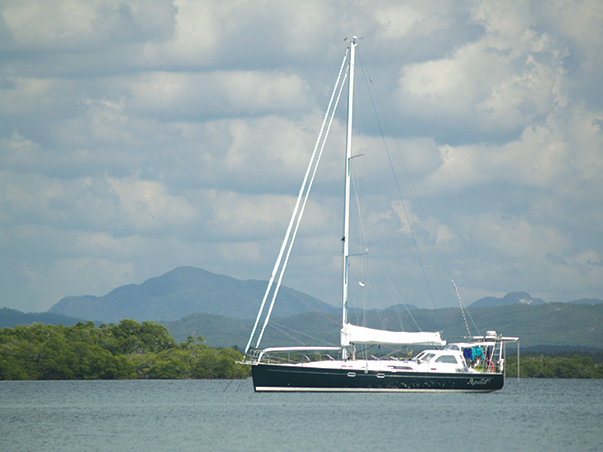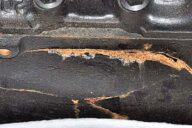Since 1960, and the beginning of the U.S. led trade embargo, Cuba has been largely off limits to Americans. Now that has all changed. Previously published in BWS by Robert Osborn.
My wife Brenda and I have wanted to visit Cuba for many years, and as relations between our two countries have begun to thaw, we decided to “jump the gun” and go before things really changed. With that in mind, we sailed there in early 2016 aboard our Aerodyne 47, Pandora, from the Bahamas for an extended two month visit exploring the south and northwest coasts.
FORMALITIES AND PAPERWORK
Receiving needed U.S. government approvals to visit Cuba, for an extended visit, proved to be quite a lesson in patience and involved nearly six months of research and much correspondence with three agencies. Finding insurance to cover Pandora while we were in Cuba was a challenge, and that didn’t fall into place until just days before leaving Georgetown, Bahamas to head for the Windward Passage. While Pantaenius has announced that they will soon be offering coverage for vessels visiting Cuba, we were only able to find coverage for our trip from a Lloyds affiliate, a costly option.
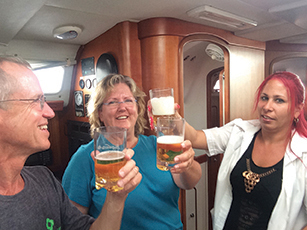
With patience, its a fascinating experience getting through customs and paperwork
The U.S. government currently allows Americans to visit Cuba for 12 specific reasons as defined by OFAC (Office of Foreign Asset Control). As we have both kept blogs for years, write articles and speak to groups, we opted to travel under a Journalism General License. At that time, and the actual processes are evolving every day, the first step involved a series of phone calls with The Office of Foreign Asset Control (OFAC), the State Department office that controls travel to places such as Cuba and North Korea, along with other “enemy states.” This office does not provide written permits but after reviewing our case, verbally agreed that our reason for visiting seemed to fall within the journalism category. As a next step, we applied for an export and re-importation permit, a SNAP-R through the Bureau of Industry and Security division of the U.S. Department of Commerce, to allow us to travel to Cuba aboard a private vessel and return to U.S. waters.
After about three months, we had secured our approval to travel to Cuba from the Bahamas and return to Ft. Lauderdale from Havana. The final step was to submit form CG3300 to the U.S. Coast Guard and as such we were required to provide them with the lat/lon coordinates of where we anticipated entering Cuban waters, within a four day window and when and where we would exit Cuban waters and return to the U.S.
A year later it is very possible that these procedures are much different so you should check with the appropriate government agencies (see call-out box for a list of resources). Our trip, designed to take advantage of strong easterly tradewinds, was to cross from Florida to the Exumas chain in the Bahamas, sail south through the southern Bahamas and Great Inagua, transit the Windward Passage between Haiti and Cuba and then travel west the 100 miles on the southern Cuban coast to Santiago de Cuba, the first port of entry.
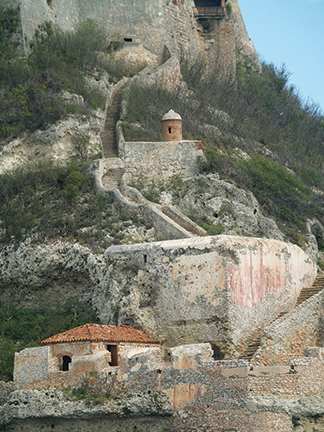
As we approached the entrance to Santiago de Cuba, we were greeted by an imposing fort guarding the harbor entrance, Castillo del Morro, built in the 1600s. What a sight. We continued past the fort and into the harbor, all the while hailing the authorities as we’d been instructed to do, but received no response.
The process of clearing in with Pandora and getting our visas proved to be, while fairly straightforward, quite an interesting experience. As we came within sight of Marina Santiago, we were finally hailed on the radio by the Guarda Frontera and instructed to anchor on the other side of the harbor in the “quarantine” area, about a mile from the marina. A short while later a launch pulled up and dropped off the health inspector, a young Cuban woman with striking cherry red dyed hair. We offered her a cold Coke which she accepted with thanks and quietly slipped it into her purse. She took our temperature with a laser thermometer pointed at our foreheads, smiled and declared Brenda to be “hot”. Yes, she can be that, I agreed.
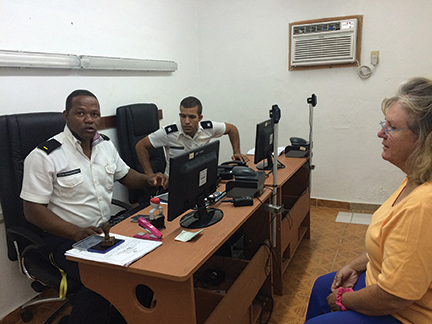
The process of clearing in was fairly straightforward
She knew very little English and patiently waited while we thumbed through the phrasebook to find answers to her questions. The whole process lasted about an hour and was very pleasant. When we were done she began talking about “toasting” our arrival. After a LOT of back and forth and puzzled looks from us, we finally realized that she wanted a beer. Of course! Brenda and I split one and the officer quaffed hers down in short order. We exchanged information about family, showed photos on our phones of our children all around, and posed for a “selfie.” What a hoot. “Welcome to Cuba!” She asked for a tip which I provided, in the amount of five dollars, and which she accepted with a thank you. Formalities completed, we raised the anchor and headed together back across the harbor and anchored near the marina as there was no room at the dock for us. We dropped the dink and took her ashore to meet with Immigration. That process took another hour and was followed by that official coming out to Pandora where he searched through nearly all our compartments, ostensibly for drugs, pornography and stowaways.
The whole process of clearing in took several hours and was very interesting. We had been told that any chicken, frozen or fresh would be confiscated but we didn’t experience this on our visit and we were surprised that a window box of herbs and flowers remained aboard Pandora unchallenged as well.
UNEXPLORED CUBA
Cuba is a large island, over 600 miles long, and our trip took us along the entire south coast and a good portion of the north coast. Interestingly, if you were to lay Cuba along the eastern Caribbean island chain heading south from the BVI, Cuba would stretch from there nearly to South America. It’s a big island, with more land mass than all of the other islands in the Caribbean combined. And, as we traveled the southern coast, at various points we found ourselves within an overnight sail to Jamaica, the Cayman Islands and finally the Yucatan peninsula, Cancun and much of Mexico. Once you reach Cabo San Antonio, the westernmost point of Cuba, it’s an easy reach to and from many points in the western Caribbean. The opening of Cuba will likely change cruiser’s perspective of what it is to visit “the Caribbean” and the ability to use Cuba as a jumping off point to Central and South America will make the western Caribbean much more accessible to cruisers than has been the case for a great many years.
Those visiting Cuba must be prepared to be self sufficient as there are very limited services, even fewer marinas and spare parts are impossible to find, especially along the less traveled south coast. Combined with the requirements of the Guarda Frontera, a sort of military coast guard that requires you to check in and out of most of the places where you are likely to stop along the way, the trip can be challenging at times for Americans who are used to going “where we want, when we want.” If you can make a point to “go with the flow” you will, as we did, find the process quite straightforward and an interesting experience.
Finding internet access, supplied via an undersea cable from Venezuela, can be remarkably frustrating as it’s mostly available in government run tourist hotels and nearby public squares with speed that varies greatly. To get online, you need an access card, sold at hotels and at Etecsa offices, the internet provider. These cards are good for one hour of moderate to slow internet. When visiting Marea del Portillo, a small fishing village, we rode in a horse-drawn carriage to check our e-mail and do a blog post at a nearby government run hotel. Talk about culture shock.
After leaving Marea del Portillo we made the short run to Cabo Cruz, a fairly remote area only recently opened up to cruisers. Almost immediately, the Guarda Frontera, commandeered a small fishing boat and required the fisherman to row out to visit us—a distance of almost a mile—with a drug sniffing cocker spaniel in tow, and asked their usual questions and checked our papers. We found the procedures in each port to be a bit different with the questions asked sometimes puzzling, such as how much fuel does your dinghy hold. In this case they took our cruising permit with them so there was no leaving until they had checked us out the morning of our departure, the only time this occurred. You can’t check into the next port without the permit, under any circumstances.
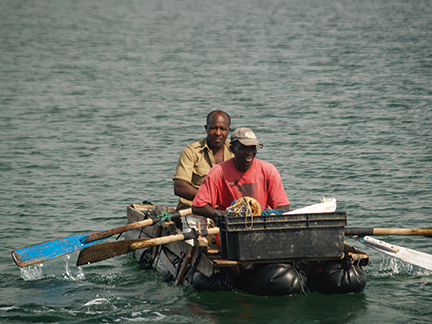
In nearly every harbor, fishermen wanted to sell us lobsters
As we sailed the south coast we were approached in nearly every harbor by fishermen who wanted to sell us lobster. In one case, after we agreed on how many and what the cost would be, the fisherman rowed a short distance from Pandora, donned fins and snorkel, jumped overboard and within moments swam over with two large lobsters and plunked them on our swim platform. Now that’s fresh lobster. In the more rural areas of Cuba lobsters are very plentiful. Sometimes we were approached multiple times a day so we were never short for an excellent seafood dinner. In one case we even traded yet one more lobster in exchange for a can of diet Coke. Only in Cuba.
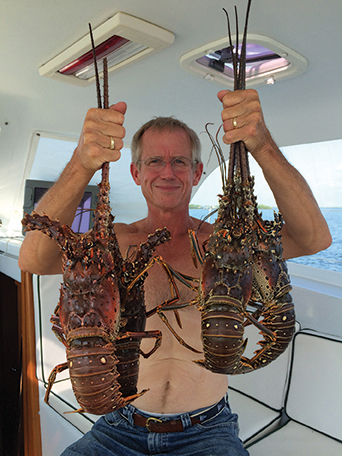
While you must check in with the Guarda Fontera in the most populated areas, there are plenty of uninhabited cayos where you can come and go as you please. And while the snorkeling is wonderful just about everywhere there are very few beaches on the southern coast, east of Cienfuegos. As a result, most cruisers tend to spend their time on the western half of the southern coast where there are many beautiful unspoiled beaches. Even in in these more populated areas, the anchorages are never crowded and more often than not, you are alone. In fact, we never saw a single U.S. flagged boat until a month into our trip when we visited Cienfuegos, the most popular stopping point for visiting boats, by far, on the south coast.
Even in Santiago de Cuba, a major port of entry, there were only a handful of boats, mostly from Europe when we visited. There are very few marinas in Cuba and even those in the larger ports are very basic by U.S. standards, generally concrete bulkheads. Good drinking water is tough to come by so many cruisers have RO units on board or if they must take on water from shore, only use this for washing and use bottled water for cooking and drinking.
Electricity at marinas can be a challenge. As it can be hot in the marinas many cruisers opted to anchor out and avoid these problems entirely. When we were on the dock Santiago de Cuba, where holding can be a challenge, the voltage dropped to less than 100 volts with only a modest draw. And in Marina Hemingway, near Havana, we encountered voltage of nearly 140 volts during the week when the tourist hotels were less occupied. Management told us that when the hotel guests departed and there was less draw on the grid the voltage was very high in certain parts of the marina.

Our time in Cuba coincided with a visit by President Obama, and many Cubans expressed hope that good would come from his visit. Additionally, it was hoped that with change the good of Cuba would not be lost in the name of progress. Everywhere we went we were greeted warmly and we always felt completely safe, both aboard and ashore. The rules in Cuba prohibit nationals visiting foreign vessels, even in marinas, and it was clear to us that these prohibitions are taken very seriously.
One of the high points of our visit was going to the free concert in Havana by the Rolling Stones which attracted a crowd estimated at one million. It was a remarkable experience, especially for those of us “of a certain age” who grew up with their music. Attendance was very international with many countries represented proudly waving their colors above the crowd so others could find them. The concert was terrific and made even more memorable by being in Havana at such an historic time. Unlike other Stones events, there wasn’t even a whiff of any illicit substances as the Cuban government has a no tolerance policy on drugs and crime. Cigarettes are cheap in Cuba and just about everyone there was smoking. The joke I heard was that “for every cigarette smoked someone loses a minute of their life and that minute goes to Keith Richards.” And, to see him and Mick Jagger strutting their stuff up on stage, like a couple of 20 somethings, that’s a lot of cigarettes.
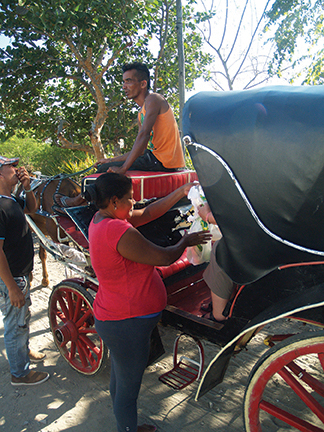
To attend the concert in Havana, from Cienfuegos, where we were visiting at the time, we took a “bus”, a converted 1952 Ford armored truck for the ride to Havana and back. Just about everywhere we turned in Cuba we spied 1950s vehicles converted into “busses” with many resembling troop carriers with canvas tops always jammed full with locals and belching exhaust as they rumbled along the roads from city to city.
While the colonial architecture and antique cars are wonderful sights all through Cuba, for us the real enchantment of visiting Cuba is the people. We loved spending time with them, especially in the most rural areas. We witnessed wonderful creativity, not only in the music and arts of this culture, but in the way everyone managed to balance living a rich and fulfilling life in a beautiful setting, with so little material wealth.
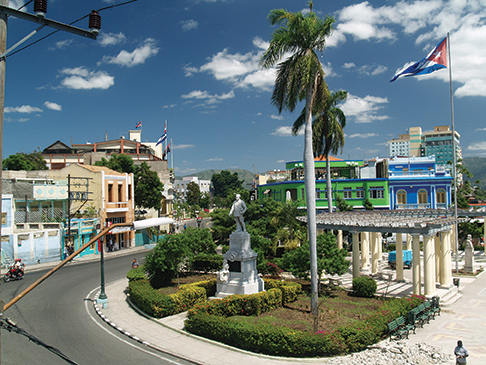
Yes, these days it’s getting easier and easier to catch a flight to Cuba from the U.S., with several airlines recently announcing daily scheduled trips. However, there is just no better way to visit Cuba than to cruise the coast, and now is the time to do so since it won’t be long before the country changes forever. The pristine reefs, the dramatic scenery and, most of all, the people are remarkable. Don’t miss out.
For more information about their voyage to Cuba check out Bob’s blog www.sailpandora.com and Brenda’s www.argoknot.com, March and April posts from 2016.
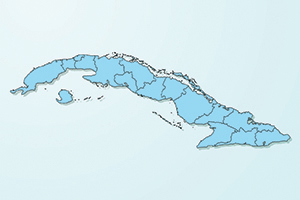 Resources
Resources
Charts: www.nvcharts.com
OFAC regulations for visiting Cuba:
https://www.treasury.gov/resource-center/sanctions/Programs/pages/cuba.aspx
USCG CG3300 form:
https://www.uscg.mil/d7/docs/Cuban%20permitCG3300.pdf
Cruising guides:
www.freecruisingguides.com, Cruising Guide to Cuba, Cheryl Barr. Cuba: A Cruising Guide, Nigel Calder.

